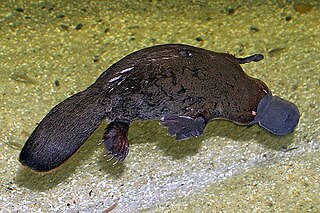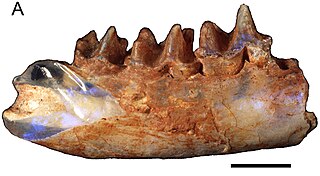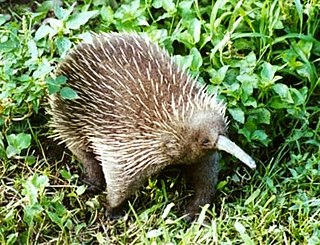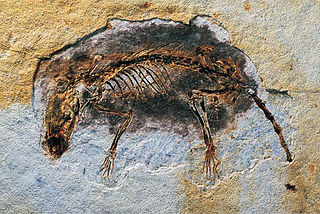
Echidnas, sometimes known as spiny anteaters, are quill-covered monotremes belonging to the family Tachyglossidae, living in Australia and New Guinea. The four extant species of echidnas and the platypus are the only living mammals that lay eggs and the only surviving members of the order Monotremata. The diet of some species consists of ants and termites, but they are not closely related to the American true anteaters or to hedgehogs. Their young are called puggles.

Monotrematum sudamericanum is an extinct monotreme species from the Paleocene (Peligran) Salamanca Formation in Patagonia, Argentina. It is one of only two monotremes found outside Oceania.

The Ornithorhynchidae are one of the two extant families in the order Monotremata, and contain the platypus and its extinct relatives. The other family is the Tachyglossidae, or echidnas.

Prototheria is an obsolete subclass of mammals which includes the living Monotremata and to which a variety of extinct groups, including Morganucodonta, Docodonta, Triconodonta and Multituberculata, have also been assigned. It is today no longer considered a valid grouping, but rather a paraphyletic evolutionary grade of basal mammals and mammaliaform cynodonts.

Kollikodon is an extinct species of mammal, considered to be an early monotreme. It is known only from an opalised dentary fragment, with one premolar and two molars in situ, as well as a referred maxillary fragment containing the last premolar and all four molars. The fossils were found in the Griman Creek Formation at Lightning Ridge, New South Wales, Australia. Kollikodon lived in the Late Cretaceous period, during the Cenomanian age. Several other monotremes are known from the Griman Creek Formation, including Dharragarra, Opalios, Parvopalus, Steropodon, and Stirtodon.

Steropodon is a genus of prehistoric platypus-like monotreme, or egg-laying mammal. It contains a single species, Steropodon galmani, that lived about 100.2–96.6 million years ago during the Cretaceous period, from early to middle Cenomanian. It is one of the oldest monotremes discovered, and is one of the oldest Australian mammal discoveries. Several other monotremes are known from the Griman Creek Formation, including Dharragarra, Kollikodon, Opalios, Parvopalus, and Stirtodon.
Teinolophos is a prehistoric species of monotreme, or egg-laying mammal, from the Teinolophidae. It is known from four specimens, each consisting of a partial lower jawbone collected from the Wonthaggi Formation at Flat Rocks, Victoria, Australia. It lived during the late Barremian age of the Lower Cretaceous.

The long-beaked echidnas make up one of the two extant genera of echidnas: there are three extant species, all living in New Guinea. They are medium-sized, solitary mammals covered with coarse hair and spines made of keratin. They have short, strong limbs with large claws, and are powerful diggers. They forage in leaf litter on the forest floor, eating earthworms and insects.

Steropodontidae is an extinct family of early monotreme mammals known from the Cretaceous of Australia.

Tribosphenida is a group (infralegion) of mammals that includes the ancestor of Hypomylos, Aegialodontia and Theria. It belongs to the group Zatheria. The current definition of Tribosphenida is more or less synonymous with Boreosphenida.

The Australosphenida are a clade of mammals, containing mammals with tribosphenic molars, known from the Jurassic to Mid-Cretaceous of Gondwana. Although they have often been suggested to have acquired tribosphenic molars independently from those of Tribosphenida, this has been disputed. Fossils of australosphenidans have been found from the Jurassic of Madagascar and Argentina, and Cretaceous of Australia and Argentina. Monotremes have also been considered a part of this group in its original definition and in many subsequent studies, but its relationship with the relationship with other members has been disputed by some scholars.

Megalibgwilia is a genus of echidna known only from Australian fossils that incorporates the oldest-known echidna species. The genus ranged from the Miocene until the late Pleistocene, becoming extinct about 50,000 years ago. Megalibgwilia species were more widespread in warmer and moist climates. Their extinction can be attributed to increasing aridification in Southern Australia.
Ausktribosphenidae is an extinct family of australosphenidan mammals from the Early Cretaceous of Australia and mid Cretaceous of South America.

Monotremes are mammals of the order Monotremata. They are the only known group of living mammals that lay eggs, rather than bearing live young. The extant monotreme species are the platypus and the four species of echidnas. Monotremes are typified by structural differences in their brains, jaws, digestive tract, reproductive tract, and other body parts, compared to the more common mammalian types. Although they are different from almost all mammals in that they lay eggs, like all mammals, the female monotremes nurse their young with milk.

Kryoryctes is a genus of prehistoric monotreme mammal from the Early Cretaceous (Albian) Eumeralla Formation of Victoria, Australia from the Otway Group of Dinosaur Cove. It is known only from a partial right humerus, estimated at 106 million years old, and contains one species, Kryoryctes cadburyi. The holotype, NMV P208094, was described in 2005 and is currently housed in the Museums Victoria Palaeontological Collection.
Teinolophidae is an extinct family of small mammals that are among the earliest known monotremes and were endemic to what would become Australia. Two genera have been described as belonging to this family: Teinolophos, and Stirtodon.
Dharragarra is an extinct genus of monotreme mammal from the Late Cretaceous (Cenomanian) Griman Creek Formation of Australia. The genus contains a single species, D. aurora, known from a partial left mandibular ramus. Dharragarra was likely more closely related to the living platypus than many other monotremes of the Cretaceous.

Ornithorhynchoidea is a superfamily of mammals containing the only living monotremes, the platypus and the echidnas, as well as their closest fossil relatives, to the exclusion of more primitive fossil monotremes of uncertain affinity.
Sundrius is an extinct genus of probable monotreme mammal from the Late Cretaceous (Albian) Eumeralla Formation of Australia. The genus contains a single species, S. ziegleri, known from a broken molar.
Stirtodon is an extinct genus of monotreme mammal from the Late Cretaceous (Cenomanian) Griman Creek Formation of Australia. The genus contains a single species, S. elizabethae, known from a large isolated premolar. Stirtodon may be the largest toothed monotreme discovered. Several other monotremes are known from the Griman Creek Formation, including Dharragarra, Kollikodon, Opalios, Parvopalus, and Steropodon.


















